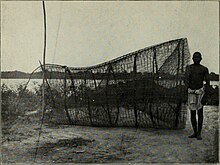Banziri


The Gbanziri (also banziri) are an ethnic group from the Central African Republic and the Democratic Republic of the Congo . They mainly live on the Ubangi . The Banziri were fishermen , traders and carriers of goods. Traditionally they used pearls and cowrie shells as body jewelry. They speak Gbanziri , which is one of the Ubangian languages .
They entered the service of the early European explorers by carrying their boats from Bangui 400 km east to the confluence of the Mbomou and Uelle and further northern tributaries of the Ubangi. Since the Gbanziri were threatened by slavers from the north, they formed an alliance with the Europeans. The chief Bamanga from the Kembé region and the French Africa researcher Paul Crampel signed a protectorate treaty on October 24, 1890. A day later, the chief Bembé from Dioukoua-Mossoua also joined this treaty. The Banziri chief Raymond Sokambi and the French colonial politician Félix Éboué had both an alliance and friendship. Abel Goumba (1926–2009) later played an important role in the politics of the Central African Republic, as did many descendants of European fathers and Banziri mothers. According to a survey from 2003 in the prefectures of Kémo and Ouaka , around 5000 people there felt they belonged to the Banziri.
Web links
Individual evidence
- ^ Library of Congress : Subject Headings, 23rd Edition, Volume II, DH , 2000, p. 1980, 2346 [1]
- ↑ Richard Bradshaw, Juan Rius Fandos-: Historical Dictionary of the Central African Republic , Rowman & Littlefield , 2016, ISBN 9780810879928 , p 190 [2]